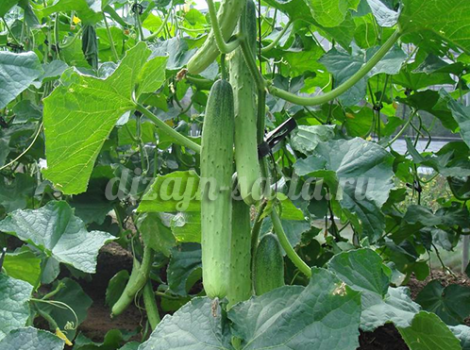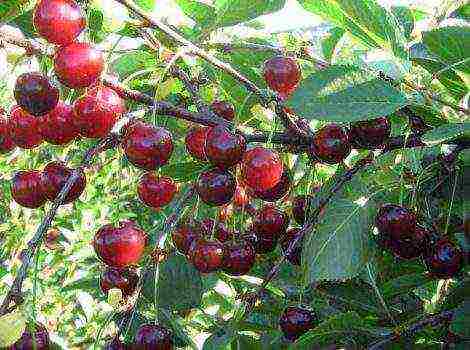Content
- 1 Hydrangea
- 2 Hydrangea paniculata
- 3 Large-leaved hydrangea
- 4 Hydrangea oakleaf
- 5 The best varieties of winter-hardy tree hydrangeas for the Moscow region
- 6 New varieties of tree hydrangeas: photo and description
- 7 Types of hydrangeas
- 8 Hydrangea paniculata: the best varieties
- 8.1 Vanilla Fraize hydrangea variety
- 8.2 Pinky Winky, DVPinky hydrangea variety
- 8.3 Hydrangea variety paniculata Grandiflora (Grandiflora)
- 8.4 Hydrangea variety paniculata Limelight
- 8.5 Phantom hydrangea variety
- 8.6 Hydrangea variety paniculata Pink Diamond
- 8.7 Wim's Red hydrangea variety
- 8.8 Bobo hydrangea variety (Bobo)
- 8.9 Fraise Melba hydrangea variety
- 8.10 Hydrangea variety paniculata Polar Bear
- 8.11 Great Star hydrangea variety
- 9 Hydrangea tree: the best varieties
- 10 Large-leaved hydrangea: the best varieties
- 11 The best varieties of panicle hydrangeas
- 12 The best varieties of tree hydrangeas
- 13 The best varieties of large-leaved hydrangeas
Hydrangea is tree-like, oak-leaved, paniculate, large-leaved ... Breeders all over the world have created a huge number of varieties of various types of hydrangeas, but not all of them take root in the open field in the middle lane. Which varieties are better to choose?
Hydrangea, also known as "Hydrangea", is a wonderful aristocrat of the garden that wins the hearts of flower growers with abundant and long flowering. Inflorescences can be spherical and hemispherical, pyramidal and flat. Of all the species of this plant, only winter-hardy deciduous shrubs, including liana-like ones, and trees up to 2 m high are widespread in the middle lane.
Hydrangea
This plant with oval bright green leaves and large spherical inflorescences about 15 cm in diameter is one of the most unpretentious representatives of its extensive family.
Among the most proven varieties of hydrangea tree the following can be distinguished:
- Annabelle, a bush up to 150 cm high with leaves of a rich green color, blooming from late May to October with large snow-white spherical inflorescences with a diameter of more than 20 cm. In the fall, Annabelle's inflorescences become greenish. Hydrangea of this variety prefers acidic fertile soil, grows well in partial shade, does not require special conditions in winter.
- Grandiflora is a spreading bush up to 2 m high with light green leaves, blooming profusely from June to September with light cream inflorescences about 20 cm in diameter.It is an unpretentious winter-hardy plant that takes root well in partial shade and in shaded areas and is often used in landscape design when creating decorative compositions.
- Sterilis Is a tree-like hydrangea variety that has a lush and long flowering from July to October. The color of large hemispherical inflorescences up to 25 cm in diameter (greenish-white at the beginning of flowering) gradually changes until it becomes snow-white.
Are gaining more and more popularity new varieties of tree hydrangea, such as:
- Pink Bella Anna - a bush up to 120 cm high with large inflorescences of rich pink tones. The characteristic features of this hydrangea variety are quick adaptation to new conditions, abundant flowering before the first frost, no special requirements for care and soil composition, high frost resistance: Pink Bella Anna hydrangea does not need shelter even at temperatures below -30 ° C.
- White House blooms profusely with luxurious white inflorescences up to 25 cm in diameter from June to September. The bush of this plant usually grows up to 150 cm in height and has a spreading domed crown.
- Invincible Spirit it is distinguished by beautiful inflorescences up to 20 cm in diameter, changing color from dark pink to bright pink during the flowering process. Hydrangea Invincible Spirit is unpretentious and frost-resistant, tolerates pruning of the shoots that have died in winter, quickly recovers, and successfully takes root in partial shade.
Hydrangea paniculata
Bushes panicle hydrangea grow to a height of 150 cm and have inflorescences that resemble pyramidal panicles. For the middle lane, this plant is quite unpretentious. Some varieties are distinguished by high frost resistance and the ability to quickly recover after the loss of a large part of the shoots.
The best varieties panicle hydrangea:
- Grandiflora with large cone-shaped inflorescences, the color of which gradually changes from creamy white to white, pink and green-red;
- Vanilla Freise with white-pink inflorescences;
- Kyushu with pinkish white inflorescences;
- Limelight with very large golden inflorescences;
- Pinky Winkyblooming pink and red.
Extremely attractive new varieties panicle hydrangea:
- Unique with white inflorescences turning pink by autumn;
- Brussels Leys with giant ivory-colored inflorescences;
- Matilda with large creamy inflorescences;
- Diamant Rouge changes color of inflorescences from white to red;
- Bombshell is a dwarf shrub covered with white flowers;
Large-leaved hydrangea
Bloom is of incredible beauty large-leaved hydrangea with large spherical inflorescences, more demanding to care than tree and paniculate. The bushes must be planted in partial shade, carefully sheltered from frost, or the seedlings must be planted in bulky containers so that it is easier to move them indoors by winter.
Most beautiful varieties large-leaved hydrangea:
- Nico blue with blue inflorescences up to 30 cm in diameter, can be grown as a houseplant;
- Alpengluchen with red flowers fits perfectly into a bright garden;
- Red Baron with beautiful leaves, it also has large inflorescences of a rich red color;
- Shniebol with luxurious white inflorescences - a new variety of large-leaved hydrangea;
- Kumiko - variety with pink inflorescences.
Hydrangea oakleaf
Heat-loving plants include oak-leaved hydrangea with dense foliage and beautiful delicate flowers, collected in large inflorescences. Mature shrubs are hardy enough, but young plants need to be covered for the winter.
The best varieties oak-leaved hydrangea:
Snowflakethat boasts adorable flowers shaped like ... that's right, snowflakes! And by the end of flowering, the petals acquire an interesting red-green hue;
The Snow Queen (or Snow Queen) in June-July dissolves beautiful white panicle inflorescences, by the end of the season the foliage acquires a rich burgundy color.
Hydrangea is a beautiful garden plant that looks very romantic both in summer, when it blooms, and in autumn, when the foliage changes its color to deep wine shades. Choose your hydrangea that will delight your eyes all season! I wonder what kind of hydrangea do you like?
Hydrangea tree in the video.
When choosing beautiful flowering plants for the garden, tree hydrangea varieties are preferred most often.They are cold-resistant enough to withstand the conditions of the average Russian climate, do not require the use of complex agrotechnical techniques when growing and will certainly delight caring owners with lush and long flowering for ten years.
This is perhaps the most common hydrangea in the gardens of central Russia. Nice, of course, but too familiar. But with plants it happens like this: everything for the time being.
The best varieties of tree hydrangea do not require special attention: they do not freeze out, they bloom annually. In the spring, you need to cut out old shoots, tie up a bush - that's, in general, that's all. Further, you can almost forget about the tree hydrangea (N. arborescens) and with confidence wait for the inevitable reward - lush flowering.
Oddly enough, but gardeners are still worried about the question: when to cut the tree hydrangea?
In the spring, her sap flow begins, and the hydrangea "cries", which causes panic among the owners. Better to trim it twice. The first - in the fall, at this time only the inflorescences are cut (the English call this decapitation) so that the snow that falls does not break the branches. The ‘Annabelle’ is especially prone to this. The second time is cut in the spring, before the start of sap flow, when the buds are not particularly swollen. Or during the appearance of young leaves, then the hydrangea already stops desperately "crying".
In a tree hydrangea, pruning of branches does not particularly affect the size of the inflorescences. In any case, not like the paniculata. However, it must be borne in mind that the size of the inflorescences is inversely proportional to the number of shoots.
Next, you can familiarize yourself with the photos, names and descriptions of the varieties of tree hydrangea, the most popular among gardeners.
The best varieties of winter-hardy tree hydrangeas for the Moscow region
One of the best varieties of tree hydrangeas for the Moscow region is 'Annabelle'!
But how will he winter? What if a shelter is still needed? And is it true that the inflorescences without any tricks on the part of the grower will be as huge as in the catalog? After more than a dozen years, we can say with confidence: the variety is wonderful!
It seems like not long ago everyone was chasing ‘Hayes Starburst’ - the first terry winter-hardy variety of hydrangeas, and then, having received the coveted plant and watching the first flowering, many were disappointed.
Apparently, they dreamed of something like a terry 'Annabelle', But here the inflorescences cannot boast of a gigantic size, the branches are thin, require support, the bush grows for a long time, and no more than a meter in height. Those who want a more luxuriant plant, and most importantly - right away, are unlikely to like this variety. This plant is exquisite, you cannot plant it in the far corner of the garden, flowers can be seen only up close. And the number of branches is a real deal, moreover, with age, they will certainly become more powerful.
Another hit we had a few years ago is the variety ‘Incrediball’... According to the description, this variety of tree hydrangea is similar to ‘Annabelle’, but it is an improved version: ‘Incrediball’ flowers are four times larger, and the diameter of the inflorescence is up to 30 cm! The main "trick" is that the inflorescence resembles a ball. However, some growers complain that they have not yet seen the promised "ball". Again, you just have to wait. Young hydrangeas may not immediately show their varietal characteristics (although, alas, a re-grading cannot be ruled out).
The ‘Invicibelle’ tree hydrangea variety is suitable for the Moscow region, it is really winter-hardy and in the spring it is found very vigorous plant! It is pointless to discuss the shade and structure of the inflorescence: some like them, some do not.
As you can see in the photo, the ‘Invicibelle’ tree hydrangea variety has a transparent, airy inflorescence, a rather complex shade - muffled, dark pink:
This is unusual for Russian gardens. But the 'Invicibelle' is interesting precisely because of its dissimilarity to other forms.
Of course, the fact that her stems lie down, and the inflorescences sometimes bow their heads, is not encouraging.But, firstly, these plants are very young in our country - in order for them to show themselves in all their glory, it will take five years, or even more. Secondly, this hydrangea needs delicate supports and no less delicate neighbors.
The variegated tree hydrangea, even if it appears, is unlikely to winter in our climate without shelter. Another thing is with purple or yellow leaves. Breeders should already be thinking about these plants!
Her inflorescences were almost like the variety 'Grandiflora', only smaller. This miracle lived for four years and then froze out in one winter with little snow. It was necessary to take the plant more seriously - at least to mulch the trunk circle in the fall.
What was the name of the cultivar? Experts in unison asserted that there is no such plant at all and cannot be.
Look at the photo of tree hydrangeas, the names of which are given above:
New varieties of tree hydrangeas: photo and description
A clear breeder's success - the new 'White Dome' tree hydrangea (sometimes sold under the name 'Dardom'). In Russia, this hydrangea has not yet found many fans. It seems that simply because it is not easy to find it. Its inflorescences are large, flat, bearing sterile flowers only along the edge. They are so delicate - they resemble Venetian lace or a ballerina's tutu. The plant itself is powerful, the branches do not linger.
Another curious variety is 'Hillsof Snow'... Its peculiarity is super-abundant flowering and flowers slightly turning pink by autumn, which, in general, is not found in tree hydrangeas.
New items ‘Bella Anna’ firmer shoots and a richer deep pink hue at peak flowering than 'Invincibelle'. The history of the 'Bella Anna' variety is rather complex: before its appearance, there were several cultivars with pink, but small inflorescences, on the basis of one of them this novelty was created.
Pay attention to the photo - the ‘Bella Anna’ tree hydrangea variety is a short bush (1-1.3 meters), with thin branches bending under the weight of huge inflorescences of a raspberry or deep pink hue:
The inflorescences are slightly pointed, which gives them an unusual appearance for treelike hydrangeas. Blooms from mid-summer until frost. Winter hardiness is high, does not tolerate stagnant moisture. It is considered one of the most spectacular and beautiful varieties of hydrangeas.
Another representative of tree hydrangeas, ‘Pink Pincushion’ variety (translated as "pink pin cushion") - a bush a little over a meter high with flat pink inflorescences. This variety of hydrangeas blooms in mid - late summer. In terms of soil, acidity and moisture, the plant is quite unpretentious. 'Pink Pincushion' is not hardy enough, requires shelter.
It differs from other tree hydrangeas in much the same way as the variety ‘Bud’ from the classic varieties of phlox. The shrub is clearly intended for fans of the exotic.
In the photo you can see the varieties of tree hydrangeas, the description of which is given on this page:
Hydrangea is not so common in our gardens. People believe that this is not a frost-hardy plant and you will not get away with it. But this is only partly true - it's all about the varieties. In this article, we will look at the best varieties of hydrangeas and its types that do great in our climatic conditions.
Types of hydrangeas
In the genus of hydrangeas of the Hortense family, there are several dozen species. These are mainly large shrubs, less often vines or trees. For our latitudes, two types are most suitable - paniculate and tree-like, bushes with spreading branches and large leaves. Shelter of hydrangea for the winter, which is described in a separate article on our website, does not present any difficulties, and in warm winters you can do without shelters at all.
Why is there a prejudice that hydrangea is a capricious plant? The fact is that flower shops have long been selling all kinds of large-leaved hydrangea in pots. But it is the large-leaved hydrangea that is frost-resistant.As a rule, these plants are beautiful only this year, and after planting in the garden, they stop blooming. Therefore, many residents of the CIS are of the opinion that hydrangea is not for our gardens. And very much in vain.
Let's take a look at what types of hydrangeas can decorate your garden.
1) Panicle hydrangea. This type of hydrangea is a bush up to 2 meters high. Hydrangea paniculata prefers moist, slightly acidic soils, feels fine on clay and alkaline soils. Calmly tolerates partial shade. The most important fact for gardeners is that panicle hydrangea varieties bloom on the shoots of the first year of life. That is, if frosts damaged the bush, then this will not affect flowering. The main difference between panicle hydrangea and tree hydrangea, another popular representative of hydrangeas, is that its inflorescences have the shape of a panicle (similar to that of a lilac), not a ball. The flowering of hydrangea paniculata is very long, and over time, the color of the flowers changes.
2) Treelike hydrangea. Perhaps the most unpretentious and frost-resistant type of hydrangea. There are not so many varieties of tree hydrangeas. Breeders are doing their job and recently a lot of new products have appeared, however, it is guaranteed that you can find a rather limited list of tree hydrangea varieties on sale. This plant is a bush with a height of 1.5-2.5 meters in the form of a dome with spherical inflorescences, the color of which changes over time. Flowers remain on the shoots until the end of the season. The tree hydrangea can winter without shelter, the main thing is to carry out sanitary pruning in the fall.
2) Large-leaved hydrangea. As already mentioned, this type of hydrangea does not differ in frost resistance, and in general requires more care than panicle and large-leaved hydrangea. This is not a small potted plant, as one might think: in favorable conditions, the large-leaved hydrangea grows up to 2.5 meters in the form of a bush with rounded inflorescences of all kinds of colors. Not so long ago, only experienced gardeners thought about planting large-leaved hydrangeas. Now, with the development of new varieties of large-leaved hydrangea, it has become possible to plant them in the middle lane. Such hydrangeas are frost-hardy (but, nevertheless, they are advised to cover them for the winter), they can bloom on the shoots of the current year.
Curly hydrangea (petiolate)
4) Curly hydrangea (petiolate). Unlike most relatives, climbing hydrangea is a vine. The shoots of this hydrangea are woody, it grows slowly. The petiolate hydrangea is used either as a ground cover crop, or as a hedge - on a trellis. Curly hydrangea can rise up to 20 meters in height, clinging to the support with suckers and aerial roots. Inflorescences are corymbose. Unfortunately, the plant is not winter-hardy enough, it needs additional shelter, therefore, residents of the southern regions of the CIS are advised to start a petiole hydrangea.
5) Hydrangea is oak-leaved. This type of hydrangea is not hardy, therefore it is advised to grow it in protected areas or in the south of the country. The peculiarity of oak-leaved hydrangea is that, in addition to inflorescences, hydrangea leaves also look very beautiful (like that of an oak, from which the name originates).
Hydrangea Oakleaf
By the way, the susceptibility of plants to diseases often depends on the type and variety of hydrangeas.
There are many more types of hydrangeas, however, in our climate, amateurs-gardeners have access to mainly tree-like, paniculate and large-leaved hydrangeas. Let's take a look at the most popular and best varieties of these hydrangeas.
Hydrangea paniculata: the best varieties
Vanilla Fraize hydrangea variety
Panicle hydrangea variety Vanilla Freise (Vanilla Freise, Rennie)
The hydrangea variety Vanilla Freise is a spreading bush up to 2 meters high. The flowers are initially pure white, but over time they take on an increasingly intense pink color. Late-flowering variety of hydrangeas, frost-resistant.The Sunday Fraze is a small copy of the Vanilla Fraze hydrangea. This type of hydrangea prefers sunny, sheltered from the wind, and moist soils.
Pinky Winky, DVPinky hydrangea variety
Pinky Winky panicle hydrangea variety
The Pinky Winky hydrangea variety is a bush 1.5-1.8 meters high with openwork conical inflorescences 15-20 cm in size. The flowers are white above, and purple-pink below. The Pinky Winky hydrangea variety blooms from mid-summer to early autumn. The variety is frost-resistant, but it is recommended to cover it in cold winters. Does not tolerate droughts.
Hydrangea variety paniculata Grandiflora (Grandiflora)
Hydrangea variety paniculata Grandiflora
The hydrangea variety Grandiflora is a large, branched bush with lush white conical inflorescences that turn pink over time. The hydrangea variety Grandiflora blooms from mid-summer to September. Loves light, but feels good in the shade. Winter-hardy plant, winter hardiness increases with age
Hydrangea variety paniculata Limelight
Hydrangea variety paniculata Limelight
The Limelight hydrangea variety is a relatively low bush up to one and a half meters high with white-green flowers of a wide conical shape, which turn pink over time. Hydrangea variety Limelight is photophilous, frost-hardy (frost resistance increases with age), does not tolerate limestone soils
Phantom hydrangea variety
This type of hydrangea has the largest of the panicle hydrangea inflorescences, the color of which varies from light cream to pinkish. The Phantom hydrangea variety is characterized by a tall bush (about 2 meters), tolerates partial shade, is very winter-hardy, and prefers fertile moist soils.
Phantom hydrangea variety
Hydrangea variety paniculata Pink Diamond
Hydrangea Pink Diamond stands out with large, but not wide, pyramidal inflorescences, at first pink or dark pink, over time - almost lilac. This hydrangea variety grows as a low-branched shrub up to two meters high. Pink Diamond hydrangea blooms in July-September. It can grow in partial shade, but does not tolerate droughts. Pink Diamond hydrangea is considered frost-resistant, but requires shelter in the first year.
Variety of hydrangea paniculata Pink Diamond
Wim's Red hydrangea variety
Weems Red is a hydrangea variety with large panicle inflorescences that change their color from white to pink and burgundy. The bush of this hydrangea variety grows up to one and a half meters in height. The flowering period is extremely long - from June to October. The plant is capable of growing in partial shade, frost-resistant (preferably covered in the first year), prefers moist acidic soils. Drought intolerant.
Hydrangea variety paniculata Weems Red
Bobo hydrangea variety (Bobo)
The variety of hydrangea paniculata Bobo was bred relatively recently and is a dwarf form with a bush height of up to 70 cm.The flowers are initially colored lemon-green, eventually turning white and pink. It blooms from mid-late summer to September. Loves semi-shady places with acidic moist soils.
Bobo hydrangea variety
Fraise Melba hydrangea variety
Hydrangea variety paniculata Frezy Melba
Like the previous hydrangea variety, Freyzi Melba was recently bred. The result of the work of the breeders is a bush with thick branches that practically do not need support up to 2 meters high and large inflorescences of a white-crimson color. The sharp, contrasting transition of crimson to white looks especially impressive. Like most hydrangeas, it is frost-resistant, loves moist acidic soils and partial shade.
Hydrangea variety paniculata Polar Bear
Hydrangea variety paniculata Polar Bear
The name of this hydrangea variety characterizes not only the color - from white-green to white and slightly pink, but also extreme winter hardiness.Hydrangea Polar Bear is the most frost-resistant among all panicle hydrangeas. The panicle hydrangea variety Polar bear grows in the form of a bush 1.5-1.7 meters high, blooms from mid-summer to the very frost. Relatively unpretentious to soils, tolerates stagnant water and droughts, can grow in partial shade, although it prefers light.
Great Star hydrangea variety
Great Star panicle hydrangea variety
Speaking about varieties of hydrangea paniculata, one cannot fail to mention the beautiful inflorescences of the Great Star variety, which look like stars with thin long curved petals. This variety of hydrangea grows as a bush up to 2 meters high with few shoots. Hydrangea Great Star tolerates partial shade, winter-hardy, does not tolerate droughts and limestone soils.
Hydrangea tree: the best varieties
Annabelle hydrangea variety
Annabelle tree hydrangea variety
The most common tree hydrangea variety is undoubtedly the snow-white beauty Annabelle. It grows in the form of a bush up to two meters high, blooms from July to cold weather. The flowers are white, large (over 20 cm in diameter). The hydrangea variety Annabel does not need shelter for the winter, prefers to grow in partial shade, does not like droughts
Hydrangea variety of tree-like Bella Anna (Bella Anna)
Bella Anna tree hydrangea variety
Hortense Bella Anna is a low bush (1-1.3 meters), with thin branches bending under the weight of huge inflorescences - crimson or deep pink. The flower petals of this variety of inflorescences are pointed, which gives them an unusual look for hydrangeas. Blooms from mid-summer until frost. Winter hardiness is high, does not tolerate stagnant moisture. It is considered one of the most spectacular and beautiful varieties of hydrangeas.
Hayes Starburst tree hydrangea variety
Hayes Starburst tree hydrangea variety
This hydrangea variety is distinguished by the fact that its flowers are double, the only one among all tree hydrangeas. Hayes Starburst is a low bush up to 1.2 meters tall with white corymbose inflorescences, which turn slightly green over time. The hydrangea variety Hayes Starburst blooms from July to the very frost, frost-hardy, feels good both in partial shade and in the light
Hydrangea variety tree-like Pink Pincushion
Hydrangea variety tree-like Pink Pincushion
Another representative of treelike hydrangeas, Pink Pincushion (translated as "pink pincushion") is a bush just over a meter high with flat pink-white inflorescences. Flowering of this variety of hydrangeas occurs in mid-late summer. In terms of soil, acidity and moisture, the plant is not quite whimsical. Pink Pincushion - not hardy enough, requires shelter.
Hydrangea variety tree-like Invincibelle Spirit
Hydrangea variety tree-like Invincibel Spirit
The hydrangea variety Invincibel Spirit ("invincible spirit") has large bright pink inflorescences, which eventually turn light pink. The bush of this hydrangea variety grows up to 1-1.2 m, in the presence of snow cover it does not need shelter
Hydrangea variety of tree-like Grandiflora (Grandiflora)
Hydrangea variety of tree-like Grandiflora
Hydrangea variety Grandiflora is one of the most common and oldest varieties of tree hydrangea, figuratively speaking - "mongrel". However, the beauty of this mongrel is not inferior to new varieties - large snow-white cap-like inflorescences change color from green to white. The diameter of the Grandiflora hydrangea inflorescences is up to 20 cm. This variety of hydrangeas is quite frost-hardy, loves light and moist fertile soils.
Large-leaved hydrangea: the best varieties
Varieties of hydrangea large-leaved series Endless Summer (Endless Summer)
Large-leaved hydrangea varieties Endless Summer - a pioneer among winter-hardy large-leaved hydrangeas. Before the breeding of the varieties of the Endless Summer series, only residents of the southern regions could think about breeding large-leaved hydrangea in the CIS. Endless Summer hydrangea varieties are not only frost-resistant, but also capable of forming flowers both on the shoots of the new year and on the shoots of the last year. Its name - Endless Summer - this hydrangea received for its ability to bloom again. Thus, this variety of hydrangeas became the "parent" of other varieties of large-leaved hydrangeas blooming on the shoots of the current year.
Large-leaved hydrangea variety Endless summer
Large-leaved hydrangea Endless summer is a bush up to one and a half meters in height, blooms in spherical inflorescences from blue to pink - depending on the acidity of the soil (alkaline soil - pink, acidic soil - blue)
Hydrangea varieties of large-leaved series Yu and Mi (You and Me, You and me)
Large-leaved hydrangea variety U and mi Tugese
Hydrangeas U & Me are a terry series of large-leaved hydrangeas. Among the most beloved varieties of hydrangea in this series are Tugese, Forever, Romance, Expression, Symphony, Eternity. It is a small shrub about 0.7-0.8 meters high with spherical inflorescences. Relatively frost-resistant - it still needs light shelter for the winter. Prefers light or light partial shade. The color of Y & Me hydrangea flowers can vary depending on the acidity of the soil (pink, purple, blue). Repaired variety, that is, it is able to bloom more than once per season
Large-leaved hydrangea variety Alpengluhen
Large-leaved hydrangea variety Alpen-Gluchen
The hydrangea variety Alpen-Gluchen stands out for its stunning red flowers, which can turn pink in acidic soils. The height of the bush of this variety is up to 1.2 meters, the flowers bloom on last year's shoots, the branches are quite powerful and sag under the weight of the flowers. Requires shelter for the winter
Large-leaved hydrangea variety Nikko Blue
Hydrangea large-leaved Nikko Blue
Nikko Blue - a variety of hydrangeas for lovers of bright blue flowers. This large-leaved hydrangea is a short bush of about 1.2 meters with lush round inflorescences up to 30 cm in diameter. Initially, they are painted white-green, but over time they become blue and even blue. The petals of Nikko Blue hydrangea inflorescences are softly rounded, which gives the flower airiness and lightness. Frost resistance is quite low, blooms on last year's shoots, likes partial shade.
To list all varieties of large-leaved hydrangea is a thankless task, as well as trying to choose the best varieties of hydrangeas from them. It is not for nothing that large-leaved hydrangeas are considered the most beautiful due to a wide range of colors, full of luxurious inflorescences. Until recently, considered a forbidden fruit, many varieties of large-leaved hydrangea are now available for residents of central Russia - the Forever and Ever series, Earley Sensation, Mini Penny, Shamrock, Ripple, Pappermint, Blue Haven, Coco Blank and many others.
We suggest you read about caring for hydrangeas in a separate article "Hydrangea: planting, care, reproduction", and about preparing hydrangeas for winter - in the article "Hydrangea: preparing for winter".
Tatiana Kuzmenko, member of the editorial board Sobcor of the Internet edition “AtmAgro. Agroindustrial Bulletin "
Review of the best paniculate, tree-like and large-leaved hydrangeas according to the reviews of florists
Hydrangea is a lush and long-flowering deciduous shrub. The thyroid inflorescences consist of fertile (bisexual) and sterile (sterile) flowers. They can be chaotically located, but more often they form viburnum-shaped inflorescences with fertile flowers in the center and sterile along the edge. There are varieties with only one type of flower. The scutellum can be flat, spherical, hemispherical, or pyramidal. Treelike and panicle hydrangeas have taken root well in Central Russia, largely due to their vitality. In the Moscow region, hydrangeas grow best in the open sun; in the southern regions of Russia, it is recommended to plant them in partial shade. In care, it is important to ensure regular and abundant watering (it is not for nothing that the Latin name for hydrangea hydrangea is translated as "a vessel with water"). We will tell you in detail about the best varieties of hydrangeas in our review.
In Russia, varieties of 3 types of hydrangea are widespread: tree, paniculate and large-leaved.
Hydrangea paniculata (Hydrangea paniculata). Shrub or standard tree 2 - 5 m high. Wild forms are found in Japan and China.Panicle hydrangea Differs in dark green leaves and burgundy shoots. Inflorescences are formed on the shoots of the current year. The buds bloom very slowly, so abundant mass flowering occurs in August. The inflorescence is a pyramidal scutellum, reminiscent of a panicle. At the time of dissolution, a greenish tint is present, then the color becomes pure white or cream, and by autumn pinkish tones with a brick tint and again a greenish tint appear. The flowering bush attracts bees with its aroma and is a good honey plant. The high frost resistance of the species makes it possible to grow it even in the North-West region. In the Moscow region, panicle hydrangeas winter without shelter. Shoots woody quickly and winter well.
Hydrangea (Hydrangea arborescens). Shrub from 1 to 3 m in height, native to North America. Unpretentious and winter hardy. Loves shading. Able to endure short-term drought: drooping leaves "come to life" immediately after abundant watering. Spherical or flat shields are formed at the tops of annual shoots. At the beginning of flowering, the inflorescences have a greenish tint, and in full dissolution they become creamy. In the inflorescences, fertile flowers predominate, and there are few sterile ones. But there are varieties with sterile inflorescences. Shields are large, with a diameter of 10 - 15 to 20 cm. It blooms from June to September. Young growth often does not ripen and freezes out, but after spring pruning, the bush grows back well. Freezing does not affect flowering.
Large-leaved hydrangea (Hydrangea macrophylla). Shrub 1 - 2 m high. In winter it leaves with green herbaceous shoots, which will become lignified only the next year. This biological feature leads to strong freezing of young growth in a harsh climate. In winter, all leaves are removed, the shoots are tied, bent to the ground and covered with lutrasil. Inflorescences are not formed on all annual shoots, so the flowering is not as abundant, unlike other types of hydrangea. Inflorescences exceed 20 cm in diameter. Dwarf varieties are good for container growing. The shape and color of the inflorescences is varied. Varieties of the "changeable" variety are able to change the color of the inflorescences depending on the chemical composition of the soil. Large-leaved hydrangeas grow best in acidic soils.
Rating of the best varieties of hydrangeas - TOP 10
The best varieties of panicle hydrangeas
|
Polar Bear 480 (for a seedling with a height of 30 - 40 cm with a closed root system) The Polar Bear variety opens our rating of the best panicle hydrangeas. The variety appeared as a result of crossing the panicle hydrangeas Limelight and Grandiflora. The variety has surpassed its parents. The shrub is 1.5 - 2 m high, very compact and tidy. Inflorescences are dense, broadly pyramidal, up to 30 - 40 cm long. Large clusters are formed on strong shoots that do not droop and retain the shape of the crown. The flowers are predominantly sterile, very large, more than 3 cm in diameter. Huge airy snow-white inflorescences fully justify the name "Polar Bear". At the beginning of the dissolution, the flowers have a delicate pistachio color, which is replaced by white and cream, at the end of summer they turn pink. On one bush, white and pink inflorescences from the base may be present at the same time. It adapts well to growing conditions, is resistant to increased gas pollution, and is rarely affected by diseases. Easy to form and recover quickly. It hibernates without shelter, but in the Moscow region and the Middle Lane, trunk circles are mulched with sawdust or needles. Main pluses:
Minuses:
|
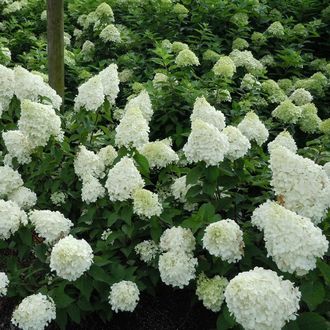 9.9 / 10 Rating Reviews I discovered hydrangeas from the Polar Bear variety. Now I grow several varieties, but I still consider the Polar Bear panicle hydrangea to be the best and most beautiful.
|
|
Phantom 450 (for a seedling with a height of 30 - 40 cm with a closed root system) A powerful, fast-growing, spreading bush, often exceeding 2 meters in height, up to 2 m wide. Shoots are strong, upright. The young growth is juicy red-brown in color, and the old shoots take on a grayish tint. Inflorescences are broadly conical with a blunt apex, more than 30 cm long, consists of large sterile flowers. In September, the creamy color changes to pale pink. Able to grow on any soil. Differs in high resistance to diseases. Even when planted on waterlogged soils, the bushes do not suffer from root rot. Shows excellent winter hardiness, and during freezing in some years it quickly recovers and blooms luxuriantly. The variety is perfect both for bush formation and for growing a standard tree. It is able to grow in one place for several decades without transplantation and rejuvenation. It propagates well by cuttings and layering. In the middle lane, it is preferable to plant in sunny areas. Main pluses:
Minuses:
|
 9.8 / 10 Rating Reviews On my site, the soil is far from ideal for hydrangeas, but the Phantom feels great, blooms with wide brushes of 25 cm long.
|
|
Vanilla Fraise 400 (for a seedling with a height of 30 - 40 cm with a closed root system) Vanille Fraise is a variety of panicle hydrangea that is very popular among gardeners. Shrub 1.5 - 2 m high, with an asymmetric wide spreading crown. This variety got the name "vanilla strawberry" for the unique color of the inflorescences. At the beginning of flowering, they are pale white, but in the sun, over time, the flowers begin to turn pink from the base, acquiring a crimson color by autumn. As a result, the individual inflorescence looks like whipped vanilla ice cream with strawberry syrup. The length of the broad-pyramidal inflorescences is 30 - 35 cm. The flowers are sterile. The shoots droop under the weight of the inflorescences. The plant is unpretentious and frost-resistant (4 - 5 zone). In the Moscow region, adult bushes hibernate without shelter, but mulching is carried out for young seedlings. Blooms in the first year of planting. Main pluses:
Minuses:
|
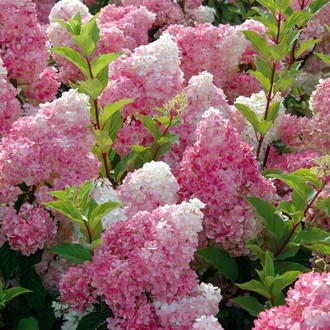 9.7 / 10 Rating Reviews I think this panicle hydrangea is the best for the Moscow region - unlike other varieties, Vanilla Freyz turns pink earlier and looks gorgeous.
|
|
Pinky Winky 400 (for a seedling with a height of 30 - 40 cm with a closed root system) Spectacular Belgian variety of panicle hydrangea. The bush in different regions has a height of 1.5 - 2.5 m. The crown of an adult plant is wide, spreading. Shoots not drooping, red-brown, standing out among the sparse leaves. White cone-shaped inflorescences with a pointed apex consist of fertile and sterile flowers, the latter prevailing. A feature of the variety is the continued growth of inflorescences in the fall. As a result, the bases turn bright purple, and new large white flowers bloom at the top. Inflorescences of medium density, directed upwards. With good care, the inflorescences already in the first flowering will be large, 20 - 25 cm long. Young bushes can not be tied up, but with age, the appearance of especially large panicles in rainy and windy weather can lead to bending of the shoots, therefore, a garter is used to support. Winter hardiness is high. Before winter, it is recommended to cut off the inflorescences to eliminate the likelihood of shoots breaking off. In some years, preventive treatments may be required. Main pluses:
Minuses:
|
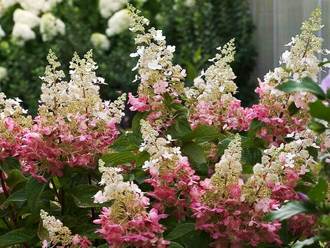 9.5 / 10 Rating Reviews I planted a seedling in a sunny place, I indulge in top dressing and rejoice at the beautiful inflorescences.Pinky Winky is a very good variety of panicle hydrangea, with proper care it will certainly thank you.
|
|
Limelight 400 (for a seedling 20-30 cm high with a closed root system) A powerful, compact bush with a height of 2 m, does not fall apart under the weight of inflorescences and does not require a garter. Shoots are green, densely leafy. Shirokopyramidalnye sterile inflorescences up to 30 cm long appear in August and decorate the bush until October. At the beginning of flowering, the flowers have a bright lime shade, which becomes yellow-green in partial shade, and snow-white in the sun. By the fall, a typical pinkish hue appears. In autumn, lilac leaves increase the decorative effect. Maintaining soil fertility is important to obtain large, greenish buds. In winter, it is recommended to cut off all inflorescences so that the shoots do not break under the weight of snow-covered brushes. Shows good resistance to disease and frost. Young bushes in a harsh winter can freeze slightly, but with age, frost resistance increases. Main pluses:
Minuses:
|
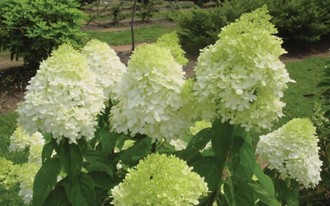 9.5 / 10 Rating Reviews Limelight is a very good variety of panicle hydrangea. On a 2-year-old seedling there were very large inflorescences, the shoots do not droop and do not fall apart in rainy weather.
|
The best varieties of tree hydrangeas
|
Annabelle 440 (for a seedling 15-25 cm high with a closed root system) Delicate tree hydrangea variety. Shrub no more than 1.5 m in height and up to 3 m in diameter. The crown is spherical, loose. Spherical inflorescences with a diameter of 15 - 25 cm consist of sterile flowers. At the beginning of the dissolution, there is a greenish tint, and then they become snow-white. The leaves remain green for a very long time, turning slightly yellow in late autumn. Shows excellent frost resistance, is rarely affected by diseases, grows quickly and easily recovers. In one place, without transplanting, the bushes grow for 40-50 years or more, without losing their decorative effect. In the Central lane, young seedlings are covered. Main pluses:
Minuses:
|
 9.7 / 10 Rating Reviews My tree hydrangea Anabel decorates the collection of conifers, they complement each other well: a white fluffy hat and juicy greenery.
|
|
Sterilis 500 (for a seedling 20-30 cm high with a closed root system) A well-known tree hydrangea variety. Shrub 1.3 - 1.9 m high with a rounded crown. The foliage is medium, the bush looks loose. Young shoots are green, pubescent. Lush hemispherical inflorescences with a diameter of 20 - 30 cm consist of large sterile flowers. In complete dissolution, inflorescences are pure white. Winter hardiness is high (zone 4 - 5), but in regions with severe winters, shelter is required. Has a high growth rate and quickly builds up shoots. For the formation of large inflorescences, it needs annual spring pruning. Main pluses:
Minuses:
|
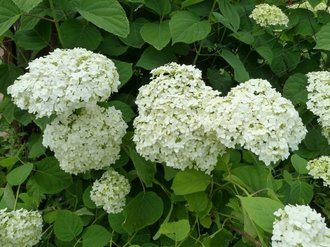 9.5 / 10 Rating Reviews I really like the huge caps of Sterilis hydrangea inflorescences, which are good when cut. I forgive him for drooping heads.
|
|
White Dome 440 (for a seedling 15-25 cm high with a closed root system) A variety of tree hydrangea. The bush is 1.2 - 1.5 m high, with a rounded crown. The leaves are large, up to 20 cm in length. Inflorescences are a flat shield, in the form of a dome with a diameter of 10 - 25 cm, in the center there are small fertile flowers, and large sterile flowers only along the edge, which gives the effect of openwork. The color of the inflorescences is creamy with a snow-white border. The shoots are strong, erect, the bush keeps its shape and without support. A spherical crown in diameter can reach 2 - 3 m. The growth force is high, the annual growth is 20 cm. Winter hardiness is high (zone 5).In the Leningrad Region and the Moscow Region, adult plants hibernate without shelter, but young ones can freeze slightly. Main pluses:
Minuses:
|
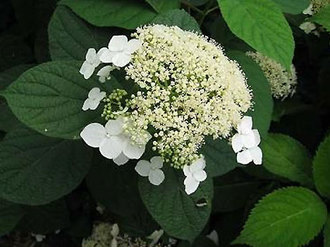 9.5 / 10 Rating Reviews Every winter I cut it into 2 buds, the bush winters well and blooms profusely. Compact and neat variety.
|
The best varieties of large-leaved hydrangeas
|
Endless Summer 500 (for a seedling 15 - 20 cm high with a closed root system) Legendary large-leaved hydrangea variety capable of blooming both on last year's shoots and on the current year's shoots. It belongs to the group of remontant varieties. This feature is important for Central Russia. Even in case of freezing, the bush in favorable conditions can please with flowering. Due to its ability to form buds several times per season, the variety was named "Endless Summer". In a sunny place, the bush does not grow higher than 1.5 m, but gives many spherical inflorescences with a diameter of 10 - 15 cm. The color of sterile flowers can vary from bright pink to blue, depending on the acidity of the soil. Often, the same plant contains inflorescences of different shades. Bright inflorescences are good for cutting, from which they form original bouquets with a delicate aroma. Despite the high declared frost resistance, in the Middle Lane it is recommended to mulch and cover the bushes with non-woven material. Main pluses:
Minuses:
|
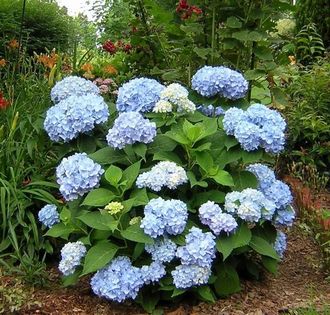 9.7 / 10 Rating Reviews The first 2 years I created the best conditions for the growth of a small hydrangea seedling, and now I enjoy a neat bush and lush flowering.
|
|
Peppermint 350 (for a seedling 15 - 20 cm high with a closed root system) Repairing variety of large-leaved hydrangea from the Forever & Ever series. The unusual two-tone color of the inflorescences attracts attention: the flowers have a wide white border, and in the center they can be pink, purple or blue. Inflorescences of large sterile flowers, up to 25 cm in diameter, in the form of a hemisphere. The height of the bush is 0.7 - 0.9 m, a compact spherical crown. Suitable for container growing. For full development, sunny areas are allocated, partial shade - only in the south. Main pluses:
Minuses:
|
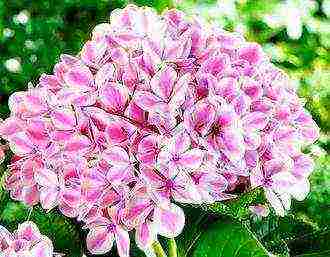 9.5 / 10 Rating Reviews The variety is good, but not for lazy growers. Requires proper treatment and a lot of attention. An adult bush hibernates under cover and blooms twice and very profusely.
|
All hydrangeas love frequent and abundant watering. For planting, areas protected from the winds are chosen from the south or east side. In landscape design, hydrangea is used as a tapeworm on the lawn or in compositions with roses, clematis, lilies, spirea, rhododendrons, barberries, lilacs and conifers. When choosing neighbors, not only aesthetic compatibility is taken into account, but also general requirements for soil composition and care. Hydrangeas complement the garden in a natural, natural style and in a sophisticated Japanese style equally well. Hedges from different varieties of the same species look spectacular.
Attention! The reliability of the information and the results of the ratings is subjective and does not constitute advertising.
